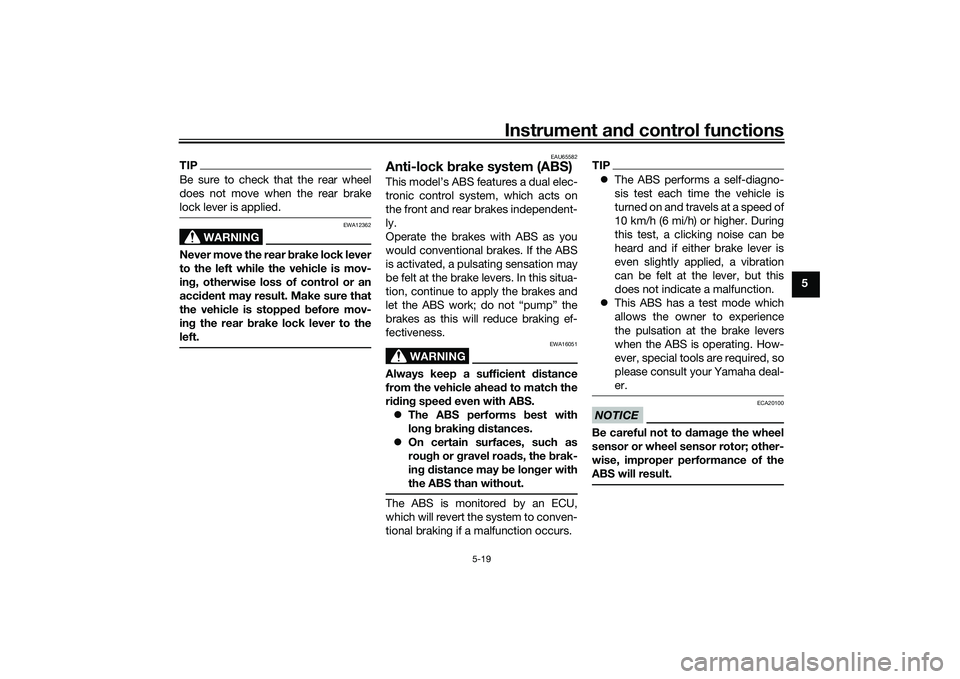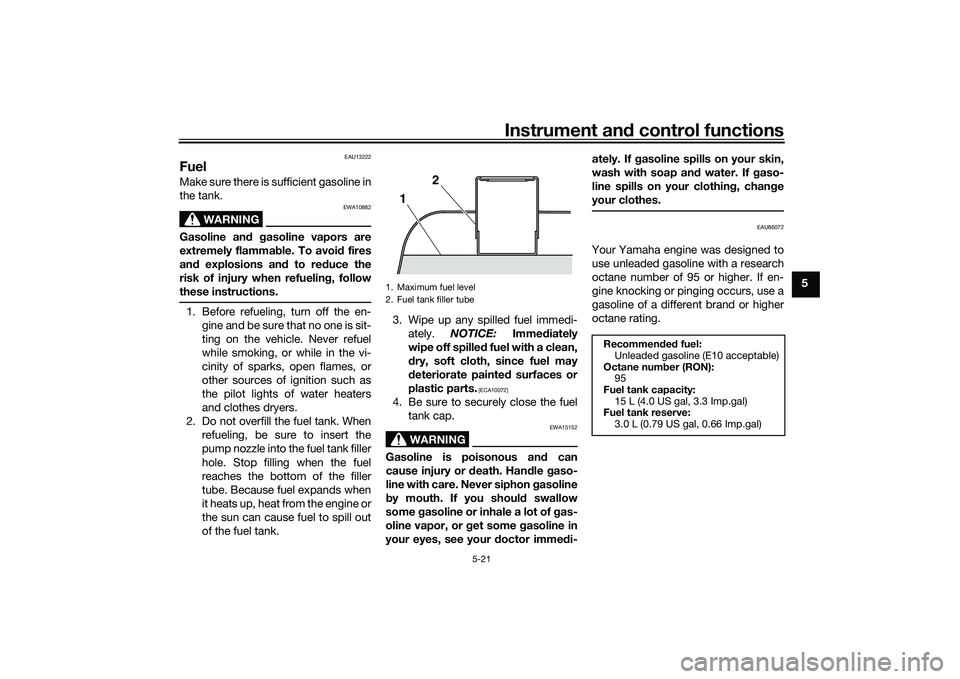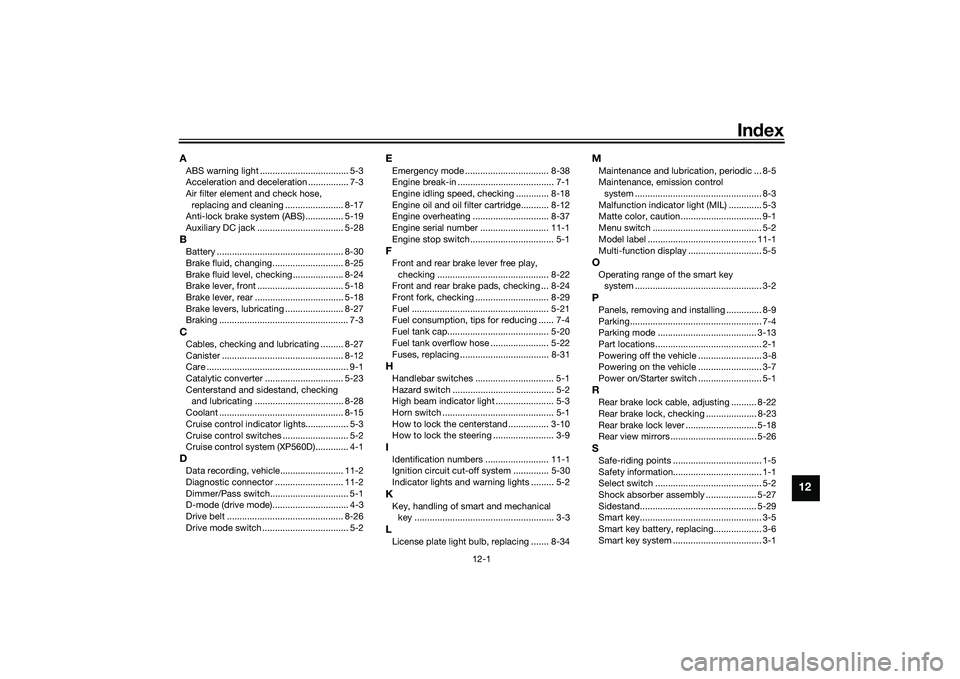warning light YAMAHA TMAX 2020 User Guide
[x] Cancel search | Manufacturer: YAMAHA, Model Year: 2020, Model line: TMAX, Model: YAMAHA TMAX 2020Pages: 126, PDF Size: 21.59 MB
Page 55 of 126

Instrument and control functions
5-19
5
TIPBe sure to check that the rear wheel
does not move when the rear brake
lock lever is applied.
WARNING
EWA12362
Never move the rear brake lock lever
to the left while the vehicle is mov-
in g, otherwise loss of control or an
acci dent may result. Make sure that
the vehicle is stoppe d b efore mov-
in g the rear brake lock lever to the
left.
EAU65582
Anti-lock brake system (ABS)This model’s ABS features a dual elec-
tronic control system, which acts on
the front and rear brakes independent-
ly.
Operate the brakes with ABS as you
would conventional brakes. If the ABS
is activated, a pulsating sensation may
be felt at the brake levers. In this situa-
tion, continue to apply the brakes and
let the ABS work; do not “pump” the
brakes as this will reduce braking ef-
fectiveness.
WARNING
EWA16051
Always keep a sufficient d istance
from the vehicle ahea d to match the
ri din g speed even with ABS.
The ABS performs best with
lon g b rakin g d istances.
On certain surfaces, such as
rou gh or g ravel roa ds, the b rak-
in g d istance may be lon ger with
the ABS than without.The ABS is monitored by an ECU,
which will revert the system to conven-
tional braking if a malfunction occurs.
TIP The ABS performs a self-diagno-
sis test each time the vehicle is
turned on and travels at a speed of
10 km/h (6 mi/h) or higher. During
this test, a clicking noise can be
heard and if either brake lever is
even slightly applied, a vibration
can be felt at the lever, but this
does not indicate a malfunction.
This ABS has a test mode which
allows the owner to experience
the pulsation at the brake levers
when the ABS is operating. How-
ever, special tools are required, so
please consult your Yamaha deal-
er.NOTICE
ECA20100
Be careful not to d amage the wheel
sensor or wheel sensor rotor; other-
wise, improper performance of the
ABS will result.
UB3TE0E0.book Page 19 Tuesday, September 17, 2019 9:35 AM
Page 57 of 126

Instrument and control functions
5-21
5
EAU13222
FuelMake sure there is sufficient gasoline in
the tank.
WARNING
EWA10882
Gasoline an d gasoline vapors are
extremely flammab le. To avoid fires
an d explosions an d to re duce the
risk of injury when refuelin g, follow
these instructions.1. Before refueling, turn off the en- gine and be sure that no one is sit-
ting on the vehicle. Never refuel
while smoking, or while in the vi-
cinity of sparks, open flames, or
other sources of ignition such as
the pilot lights of water heaters
and clothes dryers.
2. Do not overfill the fuel tank. When refueling, be sure to insert the
pump nozzle into the fuel tank filler
hole. Stop filling when the fuel
reaches the bottom of the filler
tube. Because fuel expands when
it heats up, heat from the engine or
the sun can cause fuel to spill out
of the fuel tank. 3. Wipe up any spilled fuel immedi-
ately. NOTICE: Immediately
wipe off spille d fuel with a clean,
d ry, soft cloth, since fuel may
d eteriorate painte d surfaces or
plastic parts.
[ECA10072]
4. Be sure to securely close the fuel tank cap.
WARNING
EWA15152
Gasoline is poisonous an d can
cause injury or d eath. Handle gaso-
line with care. Never siphon gasoline
b y mouth. If you shoul d swallow
some gasoline or inhale a lot of gas-
oline vapor, or g et some gasoline in
your eyes, see your doctor imme di- ately. If g
asoline spills on your skin,
wash with soap an d water. If gaso-
line spills on your clothin g, chan ge
your clothes.
EAU86072
Your Yamaha engine was designed to
use unleaded gasoline with a research
octane number of 95 or higher. If en-
gine knocking or pinging occurs, use a
gasoline of a different brand or higher
octane rating.
1. Maximum fuel level
2. Fuel tank filler tube
1 2
Recommen
ded fuel:
Unleaded gasoline (E10 acceptable)
Octane num ber (RON):
95
Fuel tank capacity: 15 L (4.0 US gal, 3.3 Imp.gal)
Fuel tank reserve:
3.0 L (0.79 US gal, 0.66 Imp.gal)
UB3TE0E0.book Page 21 Tuesday, September 17, 2019 9:35 AM
Page 71 of 126

Operation and important ri din g points
7-2
7
EAU88770
Startin g the en gineThe ignition circuit cut-off system will
enable starting when the sidestand is
be up.
To start the engine1. With the smart key turned on, ap-
proach the vehicle.
2. Push the “ON/ ” switch and set the engine stop switch to the run
position.
Upon authentication of the smart
key, the beeper will sound twice
and the centerstand and steering
locks (if applied) will be released.
3. Confirm the indicator and warning light(s) come on for a few sec-
onds, and the go off. (See page
5-2.)TIPDo not start the engine if the mal-
function indicator light remains on.
The ABS warning light should
come on and stay on until the ve-
hicle reaches a speed of 10 km/h
(6 mi/h).
NOTICE
ECA24110
If a warnin g or in dicator li ght does
not work as d escribed a bove, have a
Yamaha dealer check the vehicle.4. Close the throttle completely.
5. While applying the front or rear
brake, push the “ON/ ” switch.
6. Release the “ON/ ” switch when the engine starts, or after 5 sec-
onds. Wait 10 seconds before
pressing the switch again to allow
battery voltage to restore.NOTICE
ECA11043
For maximum en gine life, never ac-
celerate har d when the en gine is
col d!
EAU88780
TIPThis model is equipped with:
a lean angle sensor. This sensor
stops the engine in case of a vehi-
cle turnover. If this happens, the
malfunction indicator light will
come on, but this is not a malfunc-
tion. Turn the vehicle power off
and then back on again to cancel
the indicator light. Failing to do so
will prevent the engine from start-
ing even though the engine will
crank when pushing the start
switch.
an engine auto-stop system. The
engine stops automatically if left
idling for 20 minutes. If the engine
stops, simply push the start
switch to restart the engine.
UB3TE0E0.book Page 2 Tuesday, September 17, 2019 9:35 AM
Page 107 of 126

Periodic maintenance an d a djustment
8-33
8
6. Install the windshield by installing
the screws.
7. Install the caps.
8. Install the screw access covers by installing the quick fasteners.
If a fuse is blown, replace it as follows. 1. Turn the vehicle power off.
2. Remove the blown fuse, and then install a new fuse of the specified
amperage. WARNING! Do not
use a fuse of a hi gher ampera ge
ratin g than recommen ded to
avoi d causin g extensive dam-
a g e to the electrical system an d
possi bly a fire.
[EWA15132]
3. Turn the vehicle power on and turn
on the electrical circuit in question
to check if the device operates.
4. If the fuse immediately blows again, have a Yamaha dealer
check the electrical system.
1. Screw access cover
1
Specified fuses:
Main fuse:
40.0 A
Headlight fuse: 7.5 A
Taillight fuse: 7.5 A
Signaling system fuse:
7.5 A
Ignition fuse: 7.5 A
Radiator fan motor fuse: 15.0 A
Fuel injection system fuse:
7.5 A
ABS control unit fuse: 7.5 A
ABS motor fuse: 30.0 A
ABS solenoid fuse:
15.0 A
Auxiliary DC jack fuse: 2.0 A
Backup fuse: 15.0 A
Electronic throttle valve fuse:
7.5 A
Baggage fuse: 7.5 A (XP560E)
Brake light fuse: 1.0 A (XP560D)
Cruise control fuse:
1.0 A (XP560D)
Windshield motor fuse: 20.0 A (XP560D)
UB3TE0E0.book Page 33 Tuesday, September 17, 2019 9:35 AM
Page 115 of 126

Scooter care and stora ge
9-2
9
chemicals such as, solvents,
g
asoline, rust removers, b rake
flui d, or antifreeze, etc.
Before washin g
1. Park the vehicle out of direct sun- light and allow it to cool. This will
help avoid water spots.
2. Make sure all caps, covers, elec- trical couplers and connectors are
tightly installed.
3. Cover the muffler end with a plas- tic bag and a strong rubber band.
4. Pre-soak stubborn stains like in- sects or bird droppings with a wet
towel for a few minutes.
5. Remove road grime and oil stains with a quality degreasing agent
and a plastic-bristle brush or
sponge. NOTICE: Do not use
d eg reasin g a gent on areas re-
quirin g lu brication such as
seals, gaskets, an d wheel axles.
Follow pro duct instructions.
[ECA26290]
Washin g
1. Rinse off any degreaser and spray down the vehicle with a garden
hose. Use only enough pressure
to do the job. Avoid spraying wa-
ter directly into the muffler, instru-
ment panel, air inlet, or other inner
areas such as underseat storage
compartments.
2. Wash the vehicle with a quality au- tomotive-type detergent mixed
with cool water and a soft, clean
towel or sponge. Use an old tooth-
brush or plastic-bristle brush for
hard-to-reach places. NOTICE:
Use col d water if the vehicle has
b een exposed to salt. Warm wa-
ter will increase salt’s corrosive
properties.
[ECA26301]
3. For windshield-equipped vehicles: Clean the windshield with a soft
towel or sponge dampened with
water and a pH neutral detergent.
If necessary, use a high-quality
windshield cleaner or polish for
motorcycles. NOTICE: Never use
any stron g chemicals to clean
the wind shield. Additionally,
some cleanin g compoun ds for plastic may scratch the win
d-
shiel d, so b e sure to test all
cleanin g pro ducts before gen-
eral application.
[ECA26310]
4. Rinse off thoroughly with clean water. Be sure to remove all deter-
gent residues, as they can be
harmful to plastic parts.
After washin g
1. Dry the vehicle with a chamois or absorbent towel, preferably mi-
crofiber terrycloth.
2. For drive chain-equipped models: Dry and then lubricate the drive
chain to prevent rust.
3. Use a chrome polish to shine chrome, aluminum, and stainless
steel parts. Often the thermally in-
duced discoloring of stainless
steel exhaust systems can be re-
moved through polishing.
4. Apply a corrosion protection spray on all metal parts including
chrome or nickel-plated surfaces.
WARNING! Do not apply sili- cone or oil spray to seats, han d
g rips, ru bber foot pe gs or tire
trea ds. Otherwise these parts
UB3TE0E0.book Page 2 Tuesday, September 17, 2019 9:35 AM
Page 116 of 126
![YAMAHA TMAX 2020 User Guide Scooter care and stora ge
9-3
9 will
become slippery, which
coul d cause loss of control.
Thorou ghly clean the surfaces
of these parts before operatin g
the vehicle.
[EWA20650]
5. Treat rubber, vi YAMAHA TMAX 2020 User Guide Scooter care and stora ge
9-3
9 will
become slippery, which
coul d cause loss of control.
Thorou ghly clean the surfaces
of these parts before operatin g
the vehicle.
[EWA20650]
5. Treat rubber, vi](/img/51/51446/w960_51446-115.png)
Scooter care and stora ge
9-3
9 will
become slippery, which
coul d cause loss of control.
Thorou ghly clean the surfaces
of these parts before operatin g
the vehicle.
[EWA20650]
5. Treat rubber, vinyl, and unpainted plastic parts with a suitable care
product.
6. Touch up minor paint damage caused by stones, etc.
7. Wax all painted surfaces using a non-abrasive wax or use a detail
spray for motorcycles.
8. When finished cleaning, start the engine and let it idle for several
minutes to help dry any remaining
moisture.
9. If the headlight lens has fogged up, start the engine and turn on
the headlight to help remove the
moisture.
10. Let the vehicle dry completely be- fore storing or covering it.NOTICE
ECA26320
Do not apply wax to ru bber or
unpainte d plastic parts.
Do not use a brasive polishin g
compoun ds as they will wear
away the paint.
Apply sprays an d wax sparin gly.
Wipe off excess afterwar ds.
WARNING
EWA20660
Contaminants left on the b rakes or
tires can cause loss of control. Make sure there is no lu bricant
or wax on the brakes or tires.
If necessary, wash the tires with
warm water an d a mil d d eter-
g ent.
If necessary, clean the brake
d iscs an d pa ds with brake
cleaner or acetone.
Before ri din g at hi gher spee ds,
test the vehicle’s b raking per-
formance an d cornerin g b ehav-
ior.
EAU83472
Stora geAlways store the vehicle in a cool, dry
place. If necessary, protect it against
dust with a porous cover. Be sure the
engine and the exhaust system are
cool before covering the vehicle. If the
vehicle often sits for weeks at a time
between uses, the use of a quality fuel
stabilizer is recommended after each
fill-up.NOTICE
ECA21170
Storin g the vehicle in a poorly
ventilate d room or coverin g it
with a tarp, while it is still wet,
will allow water an d humi dity to
seep in an d cause rust.
To prevent corrosion, avoi d
d amp cellars, sta bles (b ecause
of the presence of ammonia)
an d areas where stron g chemi-
cals are store d.Lon g term stora ge
Before storing the vehicle long term (60
days or more):
UB3TE0E0.book Page 3 Tuesday, September 17, 2019 9:35 AM
Page 123 of 126

12-1
12
Index
AABS warning light ................................... 5-3
Acceleration and deceleration ................ 7-3
Air filter element and check hose,
replacing and cleaning ....................... 8-17
Anti-lock brake system (ABS)............... 5-19
Auxiliary DC jack .................................. 5-28BBattery .................................................. 8-30
Brake fluid, changing............................ 8-25
Brake fluid level, checking.................... 8-24
Brake lever, front .................................. 5-18
Brake lever, rear ................................... 5-18
Brake levers, lubricating ....................... 8-27
Braking ................................................... 7-3CCables, checking and lubricating ......... 8-27
Canister ................................................ 8-12
Care ........................................................ 9-1
Catalytic converter ............................... 5-23
Centerstand and sidestand, checking and lubricating ................................... 8-28
Coolant ................................................. 8-15
Cruise control indicator lights................. 5-3
Cruise control switches .......................... 5-2
Cruise control system (XP560D)............. 4-1DData recording, vehicle......................... 11-2
Diagnostic connector ........................... 11-2
Dimmer/Pass switch............................... 5-1
D-mode (drive mode).............................. 4-3
Drive belt .............................................. 8-26
Drive mode switch .................................. 5-2
EEmergency mode ................................. 8-38
Engine break-in ...................................... 7-1
Engine idling speed, checking ............. 8-18
Engine oil and oil filter cartridge........... 8-12
Engine overheating .............................. 8-37
Engine serial number ........................... 11-1
Engine stop switch................................. 5-1FFront and rear brake lever free play, checking ............................................ 8-22
Front and rear brake pads, checking ... 8-24
Front fork, checking ............................. 8-29
Fuel ...................................................... 5-21
Fuel consumption, tips for reducing ...... 7-4
Fuel tank cap........................................ 5-20
Fuel tank overflow hose ....................... 5-22
Fuses, replacing ................................... 8-31HHandlebar switches ............................... 5-1
Hazard switch ........................................ 5-2
High beam indicator light ....................... 5-3
Horn switch ............................................ 5-1
How to lock the centerstand ................ 3-10
How to lock the steering ........................ 3-9IIdentification numbers ......................... 11-1
Ignition circuit cut-off system .............. 5-30
Indicator lights and warning lights ......... 5-2KKey, handling of smart and mechanical key ....................................................... 3-3LLicense plate light bulb, replacing ....... 8-34
MMaintenance and lubrication, periodic ... 8-5
Maintenance, emission control system .................................................. 8-3
Malfunction indicator light (MIL) ............. 5-3
Matte color, caution................................ 9-1
Menu switch ........................................... 5-2
Model label ........................................... 11-1
Multi-function display ............................. 5-5OOperating range of the smart key system .................................................. 3-2PPanels, removing and installing .............. 8-9
Parking.................................................... 7-4
Parking mode ....................................... 3-13
Part locations.......................................... 2-1
Powering off the vehicle ......................... 3-8
Powering on the vehicle ......................... 3-7
Power on/Starter switch ......................... 5-1RRear brake lock cable, adjusting .......... 8-22
Rear brake lock, checking .................... 8-23
Rear brake lock lever ............................ 5-18
Rear view mirrors .................................. 5-26SSafe-riding points ................................... 1-5
Safety information................................... 1-1
Select switch .......................................... 5-2
Shock absorber assembly .................... 5-27
Sidestand.............................................. 5-29
Smart key................................................ 3-5
Smart key battery, replacing................... 3-6
Smart key system ................................... 3-1
UB3TE0E0.book Page 1 Tuesday, September 17, 2019 9:35 AM